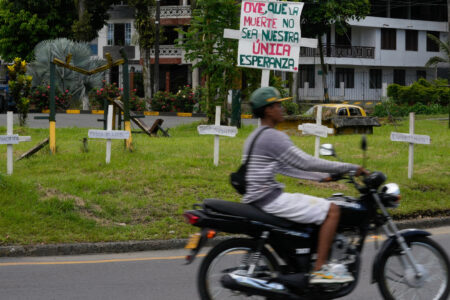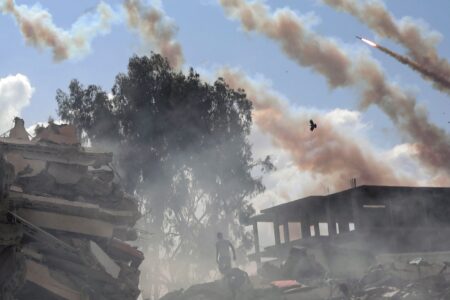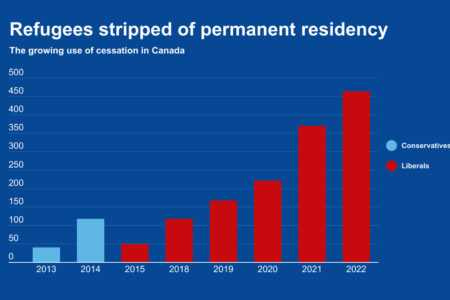
The slaughter in Syria stains the world’s conscience. And yet as the shelling and shooting go on and civilians continue to die or to flee by the thousands, the outside world seems to do little more than wring its hands at the size of the challenge, lamenting its helplessness to stop the carnage.
Just two years ago, the world’s powers rallied to send their air forces into the skies over Libya, ostensibly to come to the aid of civilians who were being threatened with annihilation by Moammar Gadhafi. As I wrote at the time in 2011 (Policy Options, October), “Few mass murderers have so clearly telegraphed their intentions” as Gadhafi did when he promised “no mercy” to the protestors of Benghazi.
The intervention was defended then as another step in the world community finding its feet — and its nerve — to look past the excuses of national sovereignty as a reason to ignore the plight of civilians. Former Liberal Foreign Minister Lloyd Axworthy wrote in the Globe and Mail that the decision of the United Nations Security Council to authorize intervention from the air was an expression of “the emerging norm of how international justice trumps sovereignty.”
The Libyan mission was an application of the UN mandate known as the Responsibility to Protect, or R2P in the jargon of international politics. Responsibility to Protect arose in reaction to the shame of the international community’s dishonourable handling of the nasty wars that marked the 1990s, from the Balkan conflagration to the Rwandan genocide, in which civilians suffered while the world watched and debated what to do about their fate, which was being decided on the ground.
The international community did not allow that mistake to be repeated in Libya. By the time Gadhafi launched his last offensive aimed at preserving his sclerotic regime, the international community had the legal tools and the political will to stop him. They did, with an air campaign that gave support to the disparate groups of rebels that rose up, willing to make the necessary and courageous sacrifices on the ground.
Gadhafi is dead, his regime eviscerated. But Libya remains a roiling, violent place that critics would say has failed to take advantage of the freedom the outside world helped deliver. That failure has also cast a shadow over R2P, providing oxygen to those governments and forces opposed to risking military interventions on behalf of some other country’s civilians.
And so we have arrived on the sidelines of Syria, asking again what our responsibilities are, and what to do.
Post-facto revulsion over the Nazi campaign to exterminate Jews galvanized global support in 1948 for the International Convention on the Prevention and Punishment of Genocide. Refugee Polish lawyer Raphael Lemkin had lost 49 relatives in the death camps. He lobbied ferociously to persuade nations that humanity must give concrete meaning to the hope of “never again.”
Mass atrocities have occurred throughout human history. But until Lemkin coined the term in 1944, we didn’t have a word for what article 2 of the Convention defines as genocide — “the deliberate and systematic destruction, in whole or in part, of an ethnic, racial, religious, or national group.”
A definition came into being, but an agreed action plan to intervene to stop it happening took decades. Even the definition fell short of need by excluding politically motivated mass killings within a country, insisted upon by the Gulag-burdened United Soviet Socialist Republics (USSR).
These went on as before. Mao Zedong’s Great Leap Forward starved an estimated 38 million Chinese between 1958 and 1961, according to authors Jung Chang and Jon Halliday in their monumental work, Mao: The Unknown Story. Between 1975 and 1979, the delusional radical leaders of the Khmer Rouge aped the Great Leap Forward, killing an estimated 1.5 million Cambodians in their mad effort to eliminate educated and urban life in favour of totalitarian ruralism. Thousands were killed because they wore glasses.
Under article 2.7 of its Charter, the United Nations is prohibited from intervening in “matters which are essentially within the domestic jurisdiction of any state.” This blanket prohibition was dearly held by most member states. The UN Charter may begin “We, the peoples,” but the UN is emphatically intergovernmental, run as its member states see fit.
State defenders of the principle of nonintervention were not just the usual suspects of the “authoritarian internationale.” Some active new democracies — India, Brazil, Indonesia, Mexico, even South Africa — remained seared by colonial experience and deeply wary of the risks of legitimizing outside interventions as a principle. Veto-wielding Russia and China were suspicious of how the Western political agenda could stretch such a principle.
Then undiluted genocide broke out in 1994 in Rwanda.
Today, scholars debate whether the Hutu massacre of Tutsis, which killed over 500,000 in the space of 100 days, could have been stopped by more forceful and timely intervention by the UN Security Council, as many, including retired Canadian General Romeo Dallaire, who commanded the UN peacekeeping force, claim.
But no debate is needed over which countries blocked a more robust UN intervention mandate in Rwanda and the immediate reinforcement of UN forces there — not the usual state supporters of nonintervention in internal affairs, but principally the United States, the United Kingdom and France. As Linda Melvern writes in her chapter in the 2007 collection edited by Allan Thompson: “For three months the Clinton administration played down the crisis and tried to impede effective intervention by UN forces. There was even reluctance to take the slightest action, such as jamming the hate radio, RTLMC, which could have saved lives.”
Critics see R2P as a cover for neo-imperialist adventures.
The issue then—as now—was an absence of political will. As former US ambassador (and founder of the International Crisis Group) Morton Abramowitz said at the time of the Rwanda genocide, “Major and minor powers alike are committed only to stop killing that harms their national interest.”
In democracies, perception of national interest typically sticks close to the sense of what the public will support back home. Willingness to intervene is no exception. As far as the Bill Clinton administration was concerned, support for humanitarian interventions had been severely depleted by the military debacle in Somalia two years earlier. The UN had agreed in 1992 to send a military coalition there to protect delivery channels for humanitarian aid in this failed and violent state run by warlords. When US soldiers were killed in a side mission aimed at bringing down principal warlord Mohammed Aidid, public recoil in the US induced an adversity to risk that was to last for almost a decade.
If public opinion was at least made uneasy by Rwanda, it was awakened by events in the Balkans, where the cautious approach of the UN and European leaders to the conflagration on the continent’s edges had failed to put out the fire. There was universal shame at the UN’s abdication in 1995 of protective responsibility for the doomed men and boys of Srebrenica. In 1999, when Serbia expelled Muslims from its autonomous province of Kosovo, images of Kosovars being herded onto trains, so redolent of archival photos of Holocaust train station scenes, finally prompted action.
A NATO bombing campaign was launched, not on the basis of a Security Council mandate (that had been vetoed by Russia in support of its Serb allies), but on the basis of a moral legitimacy to stop an ethnic cleansing.
This was the dysfunctional landscape surrounding the creation of the International Commission on Intervention and State Sovereignty, under the authority of the Jean Chrétien government, in 2000.
It would be hard to identify a more creative, effective and necessary foreign policy initiative in Canadian diplomatic history. The commission’s purpose was to provide the international community with advice on how to overcome political resistance and operational inefficiency to timely and effective interventions that could halt mass atrocities.
It fell within a new human security paradigm that had animated much of Canada’s foreign policy activism in the 1990s. The new emphasis on people rather than exclusively on states drew from evidence that, by the end of the 20th century, (1) wars were predominantly within rather than between states, and (2) 90 percent of the victims of war were civilians, a reversal of the proportion in conflicts at the century’s start when the overwhelming majority had been combatants.
The new paradigm saw governments waging war “against the people.” The people needed defence, and that required a new definition of security framed by the well-being of people. But to succeed politically, the commission needed to win over those who were opposed on grounds of state sovereignty, but also the major powers — those that had in effect blocked intervention in Rwanda.
The response emerged in the convincing argument, articulated by Oxford scholar Adam Roberts and others, that the motif of the exercise should change from the “right to intervene” to “the Responsibility to Protect.” The repositioned emphasis would be less neuralgic for those states keen to protect the integrity of article 2.7 prohibiting interference in internal affairs.
Bracketed by before and after responsibilities “to prevent” and “to rebuild,” six criteria were identified in the report under the “Responsibility to Protect” (R2P) that could justify international intervention to protect civilians:
- The right authority;
- A just cause (large-scale);
- The right intention (to halt suffering);
- Military intervention only as a last resort;
- Proportional means; and
- Reasonable prospects of success.
But the project to instill the principles in international law were set back by the 2003 US-led invasion of Iraq. Not only was the invasion launched without international sanction, but the principle of protecting civilians was cheapened when the Bush administration tried to invoke it after the fact when its original rationale for war — an imminent threat of weapons of mass destruction — came up hollow.
A 2005 UN summit tried to regain confidence in the principles of R2P. It pulled a consensus together by agreeing, among other things, that the Security Council should not be given blank cheques for intervention (the American route to the Iraq invasion), and to seek authorization for intervention on a case-by-case basis. The result was adoption of the principle that “where a government fails to prevent atrocities, foreign governments may intervene to stop them.”
That agreement has not sheltered R2P from potential abuses or criticism that it is a cover for neo-imperialist adventures. Russia felt burned by the coalition that was raised to come to the aid of Libyans, convinced that Western powers had used the authority to intervene for a wider political agenda in the region. Many critics saw the Libya mission as using humanitarian motives as a cover to dump a dictator.
Since Gadhafi’s death, sustained violence in Libya has given even proponents of R2P second thoughts about the unintended consequences of intervention. They point to developments such as the inadvertent arming of jihadists in Mali once Gadhafi’s extravagant weapons stores were thrown open, which has led to a new population coming under threat.
Jon Greenwald of the International Crisis Group (ICG) believes that the Benghazi intervention was conducted properly, but blames the leading powers in the intervention coalition for failing to follow through in ensuring a negotiated political transition to a post-Gadhafi government.
Once conflict has occurred, there is a necessity to support rebuilding; to buttress in broken countries the integrity and authority of the state while helping to build up civil society; to embed inclusive pluralism in the rule of law; and to help bring justice and reconciliation.
But it will always be easier to overthrow a dictatorship than to build a democracy in its wake.
So what are the prospects for R2P, particularly as we stare into the abyss of Syria?
Jill Sinclair was a foreign service officer who in 2000 served as the R2P Commission’s executive director. Today, she is assistant deputy minister (policy) at the Canadian Department of National Defence. She argues that R2P has become accepted as a new norm, an essential reference point, “part of the international lexicon.”
Sinclair stresses that to succeed, R2P had to have a big aspirational aspect by upholding the principle that sovereignty confers responsibilities upon the state to its people. In the succinct and eloquent assertion of South Sudanese activist Francis Deng, it holds that “sovereignty is responsibility.”
Sinclair’s advice is simple: “Don’t militarize everything about R2P.” She urges scanning the possibilities of nonmilitary forms of intervention, such as the advice from Kenneth Roth, long-time executive director of Human Rights Watch, who has urged putting thousands of humanitarian workers into rebel-held territory in Syria.
The contention that states are responsible to their people is not just a Western concept but also an African one, says Michael Abramowitz. He recalls how nations have systematically turned away from the warning signs, from Germany in 1933 to Rwanda 60 years later. But he notes that the US intelligence community is now regularly reporting on at-risk countries. The Barack Obama administration has created the interagency Atrocities Prevention Board, under White House principal and genocide scholar Samantha Power.
The ICG’s Greenwald also contends that the more R2P can be associated with proactive diplomacy and nonmilitary intervention before catastrophes emerge, the better are its chances to be accepted.
The essential point is to consistently put support for human rights, not geopolitical and power agendas, at the core of intervention. In that regard, there is a need to reconstitute the leadership of the 1990s, when countries such as Norway and Canada were able to provide the necessary edge in nudging the international community forward.
To build support for an antipersonnel mines convention and the International Criminal Court, we built coalitions, notably the Human Security Network, a unique composite of civil society and humanitarian aid agencies and like-minded governments spanning the North-South spectrum. It came to include not just the Netherlands and Austria, but also Chile, Costa Rica, Jordan, Thailand and South Africa. That model could help today, not only on R2P but on difficult international issues such as North Korean and Iranian nuclear programs.
Of course, prevention will sometimes fail, making military intervention necessary.
When that happens, the international community has to know how to do it properly. The Brahimi Panel on UN Peace Operations advised that United Nations Security Council missions must have “achievable mandates,” which means suitable rules of engagement and resources. Though the report was not adopted in 2000, its message resonates. The humiliating intimidations of UN forces in Rwanda, Bosnia and Cambodia because of insufficient mandates and resources are less likely to be repeated.
The tougher question arises over where to intervene. Why Kosovo and not Rwanda? Why Libya, not Syria?
It is a core question at a time when the appetite for intervention is on the wane. There is fatigue with war brought on by more than a decade of engagement in Afghanistan and Iraq that has failed to bring peace and security. Libya and post-earthquake Haiti have left us disillusioned about our ability to remake failed or broken states.
We face, in Greenwald’s words, “the threat of widespread malignant neglect.”
In Syria, the absence of “reasonable prospects” — a key condition of the R2P principle — makes military intervention improbable. Furthermore, the sectarian divisions inside the country have turned Syria into a proxy fight for some in the region, complicating the calculations of intervention.
Our best hope lies in using R2P as a preventative tool, to look down the road for signs of the next Syria, and to work to avert a breakdown now. Against the challenge of fatigue is the insistence that the comprehensive and indivisible human security agenda is in our security interests as well as being a humanitarian necessity. If we turn away from its lessons and become again bystanders to tragedies, the vow of “never again” will remain just words in the wind.







